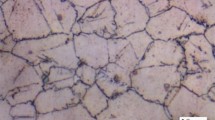Abstract
In this study, the damage tolerance behavior in terms of fatigue crack propagation behavior of an aero-engine material under a standard variable amplitude load sequence was predicted and compared with experimental results. The constant amplitude (CA) fatigue crack growth rate (FCGR) behavior of GTM718, a nickel-based super-alloy, was determined at various stress ratios R = σmin/σmax ranging from R = 0.1 to 0.7. The empirical fatigue crack growth law was derived from this data in terms of two-parameter crack driving force, ΔK*. Then, the fatigue crack propagation behavior of GTM718 under a standard cold-TURBISTAN variable amplitude load sequence was predicted using cycle-by-cycle approach and using the CA fatigue crack growth law. Also, experimental fatigue crack growth behavior under the same cold-TURBISTAN variable amplitude load sequence was determined and compared with predicted results. A fairly good correlation was observed with predicted and experimental results.







Similar content being viewed by others
References
Elber W, in Damage Tolerance in Aircraft Structures, ASTM STP 486, American Society for Testing and Materials, Philadelphia (1971), p 230.
Manjunatha C M, Int J Damage Mech 17 (2008) 477.
Newman Jr. J C, in Methods and Models for Predicting Fatigue Crack Growth Under Random Loading. ASTM STP 748, American Society for Testing and Materials, Philadelphia (1981), p 53
Newman J C, Int J Fract 80 (1996) 193.
Manjunatha C M, and Parida B K, AIAA J 42 (2004) 1536.
Newman Jr. J C, Kota K, and Lacy T E, Eng Fract Mech 187 (2018) 211.
Hertzberg R W, Newton C H, and Jaccard R, in Mechanics of Fatigue Crack Closure, ASTM STP 982, American Society for Testing and Materials, Philadelphia (1988), p 139.
Donald K, and Paris P C, Int J Fatigue 21 (1999) S47.
Tzamtzis A, and Kermanidis A T, Fatigue Fract Eng Struct 37 (2014) 751.
Paris P C, Tada H, and Donald J K, Int J Fatigue 21 (1999) S35.
Meggiolaro M A, and Pinho de Castro J T, Int J Fatigue 25 (2003) 843.
Macha D E, Corby D M, and Jones J W, Proc Soc Exp Stress Anal 36 (1979) 207.
Shin C S, and Smith R A, Int J Fatigue 7 (1985) 87.
Wei L W, and James M N, Eng Fract Mech 66 (2000) 223.
Josefson B L, Svensson T, Ringsberg J W, Gustafsson T, and De Mare J, Eng Fract Mech 66 (2000) 587.
Nandana M S, Udaya Bhat K, and Manjunatha C M, Fatigue Fract Eng Mater Struct 42 (2019) 719.
James M N, in Proceedings of the Ninth international conference on Fracture, (eds) Karihaloo B L, Mai Y-W, Ripley M I, and Ritchie R O, Sydney Australia Pergamon Press, Amsterdam 5 (1997), p 2403.
Kujawski D, Int J Fatigue 23 (2001) S239.
Kujawski D, Int J Fatigue 23 (2001) 733.
Dinda S, and Kujawski D, Eng Fract Mech 71 (2004) 1779.
Vasudevan A K, Sadananda K, and Louat N, Mater Sci Eng A188 (1994) 1.
Walker K, ASTM STP 462 (1970) 1.
Sadananda K, and Vasudevan A K, Int J Fatigue 26 (2004) 39.
Johnson W S, in Methods and Models for Predicting Fatigue Crack Growth Under Random Loading, American Society for Testing and Materials, Philadelphia (1981), p 85.
Sree P C, and Kujawski D, in ASME International Mechanical Engineering Congress and Exposition (Vol. 46583, p. V009T12A033) American Society of Mechanical Engineers (2014).
Malipatil S G, Majila A N, Fernando C D, and Manjunatha C M, in Proceedings of ICDMC 2019, (eds) Yang L J, Haq A, and Nagarajan L, Lecture Notes in Mechanical Engineering, Springer, Singapore (2020), p 379.
ASTM, Standard Test Method for Measurement of Fatigue Crack Growth Rates, ASTM E 647–95, American Society for Testing and Materials PA 3.01 (1997), p 578.
Ten Have A A, Cold Turbistan - final definition of a standardized fatigue test loading sequence for tactical aircraft cold section engine disc, Nationaal Lucht-en Ruimtevaartlaboratorium (1987) NLR TR 87054 L.
ASTM, Standard Practices for Cycle Counting in Fatigue Analysis, ASTM E 1049–85, American Society for Testing and Materials PA 3.01 (1997), p 726.
Caton M J, John R, Porter W J, and Burba M E, Int J Fatigue 38 (2012) 36.
Boyce B L, and Ritchie R O, Eng Fract Mech 68 (2001) 129.
Paris P C, and Erdogan F, J Basic Eng 85 (1963) 528.
Malipatil S G, Majila A N, Fernando C D, Manjunatha C M, In Fatigue, Durability, and Fracture Mechanics, Proceedings of Fatigue Durability India 2019, (eds) Seetharamu S, Thimmarayappa Jagadish T, and Ravindra R Malagi, Lecture Notes in Mechanical Engineering, Springer, Singapore (2021), p 375.
Manjunatha C M, AIAA J 44 (2006) 396.
Nandna M S, Udaya Bhat K, and Manjunatha C M, Trans Indian Inst Met (2020) 1.
Hou J, Wescott R, and Attia M, Eng Fract Mech 131 (2014), 406.
Schijve J, Skorupa M, Skorupa A, Machniewicz T, and Gruszczynski P, Int J Fatigue 26 (2004) 1.
Acknowledgements
The authors are thankful to Mr. JJ Jadhav, Director, NAL, and Mr. MZ Siddique, Director, GTRE, for facilitating the conduct of these experiments and for providing the permission to publish this work. The technical staff members of Materials Evaluation Laboratory, Structural Integrity Division, CSIR-NAL, are thanked for their help in conducting the tests.
Author information
Authors and Affiliations
Corresponding author
Additional information
Publisher's Note
Springer Nature remains neutral with regard to jurisdictional claims in published maps and institutional affiliations.
Rights and permissions
About this article
Cite this article
Malipatil, S.G., Majila, A.N., Fernando, D.C. et al. Damage Tolerance Behavior of a Nickel-Based Super-alloy GTM718 Under Cold-TURBISTAN Variable Amplitude Loads. Trans Indian Inst Met 74, 901–907 (2021). https://doi.org/10.1007/s12666-021-02212-x
Received:
Accepted:
Published:
Issue Date:
DOI: https://doi.org/10.1007/s12666-021-02212-x




